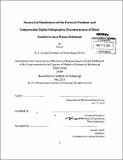| dc.contributor.advisor | George Barbastathis. | en_US |
| dc.contributor.author | A., Disi | en_US |
| dc.contributor.other | Massachusetts Institute of Technology. Department of Mechanical Engineering. | en_US |
| dc.date.accessioned | 2014-06-13T22:36:04Z | |
| dc.date.available | 2014-06-13T22:36:04Z | |
| dc.date.copyright | 2014 | en_US |
| dc.date.issued | 2014 | en_US |
| dc.identifier.uri | http://hdl.handle.net/1721.1/87954 | |
| dc.description | Thesis: S.M., Massachusetts Institute of Technology, Department of Mechanical Engineering, 2014. | en_US |
| dc.description | Cataloged from PDF version of thesis. | en_US |
| dc.description | Includes bibliographical references (pages 91-95). | en_US |
| dc.description.abstract | TFT (Thin-film transistor) - LCD (Liquid-crystal display) is now widely used by the display industry for the reason that LCD is compact and light with very low power consumption; moreover, it has little or no flicker and no geometric distortion. However, small defects from the bottom layers could grow after the deposition process and result in defective panels. Such tiny objects on the scale of ~102 nm are too small for modem cameras to directly image and generally requires (scanning) microscopy during industrial inspection process, which unfortunately leads to a tremendous cost. This thesis investigates a holographic imaging approach combined with a compressive signal reconstruction framework to automatically locate such small defects from FDTD simulation results. Holography records the electric field from a sparse distribution of particle scattering; compressive sensing retrieves a clean signal from the original measured signal corrupted by shot noise and other system noise with a sparsity prior and auto-parameter tuning based on signal characteristics. Strong denoising parameter reduces false alarms and increases miss detection at the same time. The compressive framework is followed by a defect candidate selection process which helps to eliminate false alarms while preserving the desired signal by comparing the compressive reconstruction result to the direct signal back-propagation estimate. Auto-parameter tuning finds the compressive (denoising) parameter according to the strength of noise present in the direct measurement. The accuracy and reliability of using this method to localize cylindrical defects on the scale of 102 nm is studied. This method is able to accurately cover detection of most cylindrical defects of different sizes under 0.2 sec exposure time per field of view. The accuracy is compromised for extremely small defects on a similar size scale to a cylindrical defect of 100 nm in diameter and 100 nm in height. | en_US |
| dc.description.statementofresponsibility | by Disi A. | en_US |
| dc.format.extent | 95 pages | en_US |
| dc.language.iso | eng | en_US |
| dc.publisher | Massachusetts Institute of Technology | en_US |
| dc.rights | M.I.T. theses are protected by copyright. They may be viewed from this source for any purpose, but reproduction or distribution in any format is prohibited without written permission. See provided URL for inquiries about permission. | en_US |
| dc.rights.uri | http://dspace.mit.edu/handle/1721.1/7582 | en_US |
| dc.subject | Mechanical Engineering. | en_US |
| dc.title | Numerical simulations of the forward problem and compressive digital holographic reconstruction of weak scatterers on a planar substrate | en_US |
| dc.type | Thesis | en_US |
| dc.description.degree | S.M. | en_US |
| dc.contributor.department | Massachusetts Institute of Technology. Department of Mechanical Engineering | |
| dc.identifier.oclc | 880675780 | en_US |
